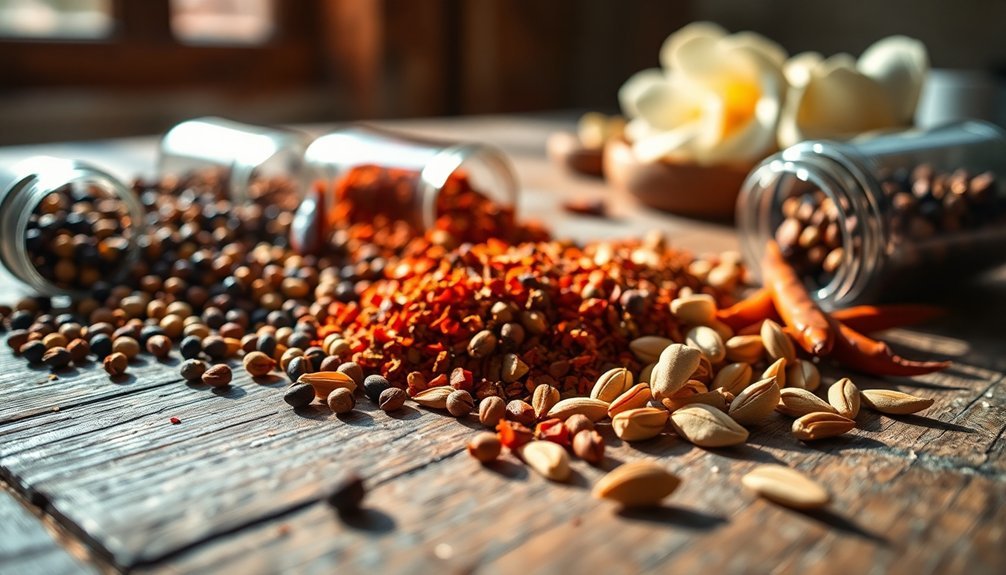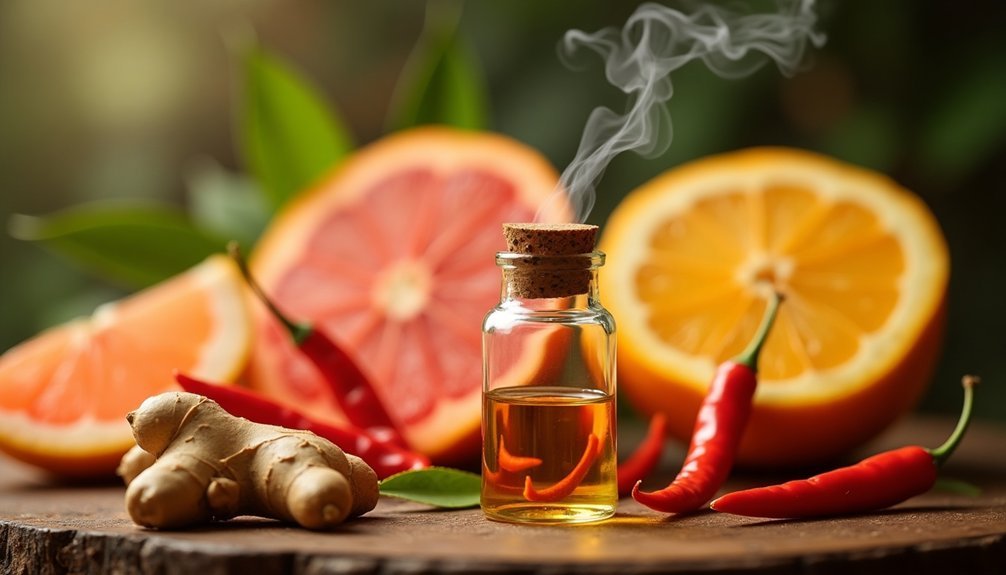When selecting bold spicy top notes for natural perfumes, you'll want to focus on vibrant ingredients like pink pepper, ginger, and cardamom that create immediate impact. Balance these invigorating spices with complementary citrus or herbal notes to achieve lasting impressions. Start with small amounts and test directly on your skin to assess how the spices interact with other elements. The secrets to mastering spicy top notes lie in understanding their unique characteristics and seasonal versatility.
Understanding Spicy Top Notes in Natural Perfumery

Spicy top notes serve as the first bold impression in natural perfumery, creating an immediate sensory impact through vibrant ingredients like pink pepper, ginger, and cardamom.
When you're working with these aromatic elements, you'll notice they quickly evaporate while setting the stage for deeper heart notes that follow.
In natural perfumery, these spicy ingredients offer more complex and nuanced aromas than their synthetic counterparts. You'll find they create warm, invigorating sensations that make your fragrance both exotic and comforting.
To craft a successful natural perfume, you'll need to carefully consider how your chosen spicy top notes interact with other components. The key is achieving a harmonious balance throughout the fragrance's evolution, ensuring each note complements the others while maintaining its distinctive character.
Essential Spices That Define Bold Opening Notes
When crafting bold opening notes in natural perfumes, you'll find several essential spices that consistently deliver powerful first impressions. Black pepper and ginger create invigorating profiles, while cardamom offers a sweet, aromatic touch that adds depth to fragrance formulations. Clove brings an intense warmth that's perfect for exotic blends.
- Pink pepper stands out as a versatile choice, providing a bright, zesty kick that evokes warmth and vibrancy in your natural perfumes.
- Ginger's fresh, fiery quality pairs beautifully with other bold spicy top notes, creating dynamic combinations that capture attention.
- Cardamom's sweet-spicy profile adds sophistication to your initial impression, making it an excellent choice for complex formulations.
These essential spices work together to create memorable opening statements in your perfume compositions.
Blending Techniques for Lasting Spicy Impressions

Building lasting spicy impressions requires thoughtful blending techniques that go beyond simply combining powerful top notes.
You'll want to balance your spicy fragrance by pairing bold elements like pink pepper and cardamom with complementary ingredients such as citrus or herbs to create a more complex olfactory experience.
To enhance your fragrance profile's longevity, consider using higher concentrations of essential oils in your formulation, particularly for top notes.
You can strengthen your spicy notes by layering them with woody heart notes, creating depth that evolves beautifully on the skin.
Don't forget to incorporate natural fixatives like resins or balsams – they'll help stabilize volatile top notes and guarantee your creation maintains its character throughout wear.
These techniques will transform your bold opening into a lasting impression that captivates throughout the day.
Seasonal Considerations for Spicy Top Notes
When crafting seasonal fragrances, you'll find that bold spicy top notes like pink pepper and ginger work best in winter blends, creating warmth against the cold, while lighter combinations suit summer's heat.
Your spring perfumes can benefit from gentler spices like cardamom paired with fresh florals, offering a perfect balance of warmth and brightness.
For fall compositions, you'll want to embrace warming notes such as cinnamon and nutmeg, which naturally complement the season's cozy atmosphere and create an inviting olfactory experience.
Summer Vs Winter Blends
As the seasons shift throughout the year, your choice of spicy top notes should adapt accordingly.
Summer blends thrive with lighter, invigorating notes like pink pepper and ginger, offering a revitalizing kick that's perfect for outdoor activities.
Winter blends, however, call for deeper spices such as cinnamon and clove, creating coziness and comfort during colder months.
When crafting natural perfumes, consider these seasonal distinctions:
- Summer fragrances benefit from balancing spicy top notes with citrus and light florals for daytime wear.
- Winter blends allow for richer combinations that feel warm and inviting, especially for evening occasions.
- Temperature affects scent perception, so adjust your fragrance families accordingly – lighter in summer, deeper in winter.
Spring Spice Pairings
Spring's awakening calls for a delicate balance of bold spicy top notes in natural perfumes. You'll find that combining invigorating cardamom and pink pepper with revitalizing citrus creates vibrant spring blends that capture the season's energy. When you're crafting your olfactory experience, consider pairing these spicy elements with fresh herbs for added dimension.
| Spicy Note | Perfect Spring Pairing |
|---|---|
| Cardamom | Bergamot |
| Pink Pepper | Fresh Basil |
| Ginger | Lemon |
| Black Pepper | Mint |
| Coriander | Orange Blossom |
As temperatures warm, your spicy top notes will interact differently with floral elements and herbs. Test your combinations during spring days to verify they maintain the right balance of warmth and revitalization. You'll discover that natural perfumes shine when spicy notes complement the season's natural vibrancy.
Fall's Warming Notes
During autumn's crisp days, bold spicy top notes reach their peak potential in natural perfumes. Your fall fragrances can embrace warming elements like ginger, cinnamon, and pink pepper to create an experience that perfectly matches the season's cozy atmosphere.
These spicy notes enhance your emotional well-being by evoking memories of harvest celebrations and seasonal gatherings.
When choosing natural perfumes for fall, consider these essential elements:
- Spicy top notes that flow smoothly into heart and base notes throughout the day
- Botanical ingredients that provide authentic warmth without synthetic compounds
- Seasonal scents that complement autumn activities and create nostalgic connections
You'll find that these bold, spicy elements in your natural perfumes not only align with fall's character but also provide a lasting, evolving fragrance experience that captures autumn's essence.
Testing and Evaluating Spice Combinations
You'll get the most accurate results by testing spicy combinations directly on your skin using a systematic method that tracks how different spice notes unfold over time.
Create a progression chart to document how your chosen spices interact with your body chemistry, noting the evolution from initial application through the dry-down phase.
To discover winning combinations, experiment with layering various spicy elements and track their compatibility with other fragrance families through detailed testing notes.
Core Sample Testing Methods
Effective core sample testing requires three key steps to evaluate spicy top notes for natural perfumes.
You'll need to systematically assess each fragrance combination on both scent strips and skin, allowing time for the fragrance evolution to reveal its true character. To maintain your olfactory sensitivity, limit your testing to a few samples per session.
- Apply different spicy top notes to separate test strips and skin patches, noting your personal impressions immediately.
- Wait for the top notes to evaporate, revealing the heart notes beneath.
- Document the longevity and sillage of each combination throughout the testing period.
Your detailed observations during core sample testing will help you identify which spicy top notes work best for your natural perfumes, considering both their initial impact and how they develop over time.
Spice Note Progression Charts
Tracking spice note progressions through detailed charts provides essential insights into how your fragrance combinations evolve over time.
You'll discover how your spicy top notes interact with other layers of your perfume while documenting their journey through detailed progression charts.
When you're testing spice combinations, focus on balancing warm and fresh notes to create harmonious formulations.
You can experiment with different concentrations of essential oils, CO2 extracts, and absolutes to enhance your fragrance's complexity and depth.
Your progression charts will help you monitor how these various forms contribute to the overall aromatic experience.
Cross-Compatibility Layering Analysis
While developing natural perfumes, systematic cross-compatibility testing reveals how different spicy top notes interact and complement each other.
You'll need to take into account the volatility and evaporation rates of each ingredient to achieve a balanced composition that delivers both initial impression and long-lasting appeal.
- Test combinations on skin or scent strips to experience how layering affects sillage and overall character
- Document the sensory journey of each spicy top note to identify successful pairings
- Take into account seasonal occasions and personal preferences when evaluating unique scents
Common Mistakes to Avoid When Working With Spicy Notes
Although spicy notes can add excitement and character to natural perfumes, several common mistakes can derail your fragrance creation. You'll want to avoid overloading your blend with intense spices, as this masks other important elements and disrupts fragrance balance. When working with volatile notes like ginger or black pepper, carefully consider their initial impression to prevent overwhelming top notes.
| Mistake | Solution |
|---|---|
| Overloading spices | Balance with heart notes |
| Ignoring volatility | Test development time |
| Rushing evaluation | Allow proper evolution |
| Using synthetic substitutes | Choose natural ingredients |
| Testing on paper only | Apply to skin for accurate assessments |
Remember that your body chemistry plays an essential role in how spicy notes develop. Don't rely solely on paper strips for testing – always evaluate on skin to understand how the fragrance truly performs.
Frequently Asked Questions
What Perfume Notes Are Spicy?
You'll find classic spicy notes in cinnamon, clove, nutmeg, pink pepper, ginger, and cardamom. These warming ingredients create depth in your perfumes and provide a rich, inviting aroma that's uniquely distinctive.
What Are the Most Seductive Notes in Perfume?
You'll find that musk, amber, vanilla, jasmine, and spicy notes like cardamom are considered highly seductive. These notes create an intimate, warm, and sensual atmosphere that's known to attract and captivate others.
What Perfume Notes Attracts Guys the Most?
You'll find that warm, spicy notes like cardamom, cinnamon, and pink pepper tend to attract men most effectively. These scents create an alluring aura while vanilla and musk undertones enhance their magnetic appeal.
What Makes Perfume Smell Spicy?
Your perfume smells spicy due to ingredients like pink pepper, cardamom, ginger, and cinnamon. These warm, exotic spices blend with resins and balsams to create that rich, aromatic kick you're detecting.
In Summary
When you're working with spicy top notes in natural perfumery, you'll find they're both challenging and rewarding. Remember to start with small amounts, test your blends thoroughly, and pay attention to seasonal appropriateness. Don't rush the process – let your creations mature and evolve. With practice and patience, you'll master the art of crafting bold, memorable fragrances that capture the essence of natural spices.





Leave a Reply